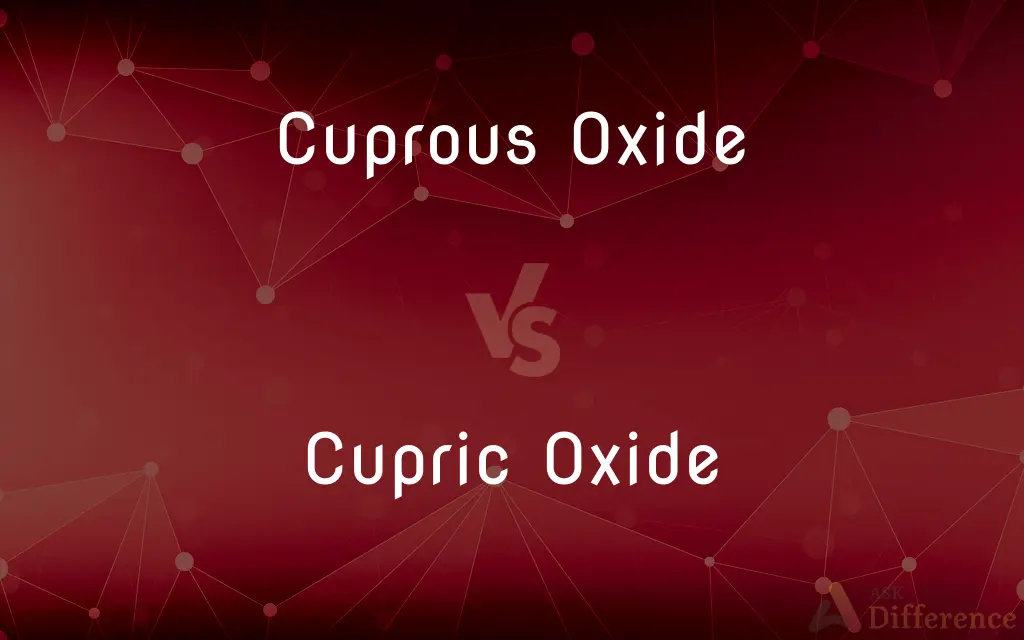Cuprous Oxide vs. Cupric Oxide — What's the Difference?
By Tayyaba Rehman — Published on January 16, 2024
Cuprous oxide (Cu2O) is a red oxide of copper with +1 oxidation state; cupric oxide (CuO) is a black oxide with copper in +2 oxidation state.

Difference Between Cuprous Oxide and Cupric Oxide
Table of Contents
ADVERTISEMENT
Key Differences
Cuprous oxide, chemically represented as Cu2O, contains copper in the +1 oxidation state. It is commonly known as red oxide of copper due to its distinct red or reddish-brown color. Cuprous oxide is less common than its counterpart and has unique properties that distinguish it from cupric oxide.
Cupric oxide, with the chemical formula CuO, has copper in the +2 oxidation state. This oxide of copper is known for its black color and is more prevalent in various applications compared to cuprous oxide. Cupric oxide has different chemical and physical properties due to the higher oxidation state of copper.
In terms of composition, cuprous oxide has two copper atoms bonded to one oxygen atom. This structure contributes to its red color and specific uses in industries. Cuprous oxide is often used in antifouling paints and as a fungicide.
Contrastingly, cupric oxide has one copper atom bonded to one oxygen atom. Its black color and different chemical properties make it suitable for various applications. Cupric oxide is widely used in ceramics, as a pigment, and in the production of copper salts.
Understanding the differences between cuprous oxide and cupric oxide is essential in fields like chemistry and material science. While both are oxides of copper, their distinct oxidation states, colors, and applications set them apart.
ADVERTISEMENT
Comparison Chart
Oxidation State
Copper in +1 oxidation state.
Copper in +2 oxidation state.
Color
Red or reddish-brown.
Black.
Chemical Composition
Two copper atoms bonded to one oxygen atom.
One copper atom bonded to one oxygen atom.
Common Uses
Used in antifouling paints, fungicides.
Used in ceramics, pigments, copper salts.
Prevalence
Less common compared to cupric oxide.
More common and widely used.
Compare with Definitions
Cuprous Oxide
An oxide used in the production of fungicides.
Cuprous oxide effectively controls plant fungal diseases.
Cupric Oxide
CuO, consisting of one copper atom and one oxygen atom.
The black powder in the lab is cupric oxide.
Cuprous Oxide
A compound with distinctive red or reddish-brown color.
The pigment in the paint is derived from cuprous oxide.
Cupric Oxide
A black oxide of copper with a +2 oxidation state.
Cupric oxide is used in the manufacture of copper salts.
Cuprous Oxide
A less common form of copper oxide.
In our experiment, we used cuprous oxide for its unique properties.
Cupric Oxide
A more common and widely used form of copper oxide.
Our study focused on the properties of cupric oxide.
Cuprous Oxide
A red oxide of copper with a +1 oxidation state.
Cuprous oxide is used in antifouling paints for ships.
Cupric Oxide
A compound used in various industrial applications.
Cupric oxide is essential in producing certain types of batteries.
Cuprous Oxide
Cu2O, composed of two copper atoms and one oxygen atom.
The red color of the mineral is due to cuprous oxide.
Cupric Oxide
An oxide used in ceramic glazes and pigments.
The artist used cupric oxide to achieve the unique glaze color.
Common Curiosities
What is the oxidation state of copper in cuprous oxide?
Copper is in the +1 oxidation state in cuprous oxide.
What are some uses of cuprous oxide?
Cuprous oxide is used in antifouling paints and fungicides.
What color is cuprous oxide?
Cuprous oxide is red or reddish-brown.
Is cuprous oxide used in ceramics?
Cuprous oxide is not typically used in ceramics; cupric oxide is.
Is cupric oxide used in paints?
Cupric oxide is used in ceramics and pigments, not commonly in paints.
Is cupric oxide harmful?
Cupric oxide can also be toxic and should be handled with care.
Can cupric oxide conduct electricity?
Cupric oxide also has semiconducting properties.
What are some uses of cupric oxide?
Cupric oxide is used in ceramics, pigments, and producing copper salts.
Is cuprous oxide common?
Cuprous oxide is less common compared to cupric oxide.
What is the oxidation state of copper in cupric oxide?
Copper is in the +2 oxidation state in cupric oxide.
Can cuprous oxide be used in batteries?
Cuprous oxide is not typically used in batteries; cupric oxide is.
Is cuprous oxide harmful?
Cuprous oxide can be toxic if ingested or inhaled in large quantities.
What color is cupric oxide?
Cupric oxide is black.
Can cuprous oxide conduct electricity?
Cuprous oxide has semiconducting properties.
Are both cuprous oxide and cupric oxide naturally occurring?
Yes, both can be found in nature, though they can also be synthesized.
Share Your Discovery

Previous Comparison
Este in Spanish vs. Esta in Spanish
Next Comparison
Prim’s Algorithm vs. Kruskal’s AlgorithmAuthor Spotlight
Written by
Tayyaba RehmanTayyaba Rehman is a distinguished writer, currently serving as a primary contributor to askdifference.com. As a researcher in semantics and etymology, Tayyaba's passion for the complexity of languages and their distinctions has found a perfect home on the platform. Tayyaba delves into the intricacies of language, distinguishing between commonly confused words and phrases, thereby providing clarity for readers worldwide.
















































